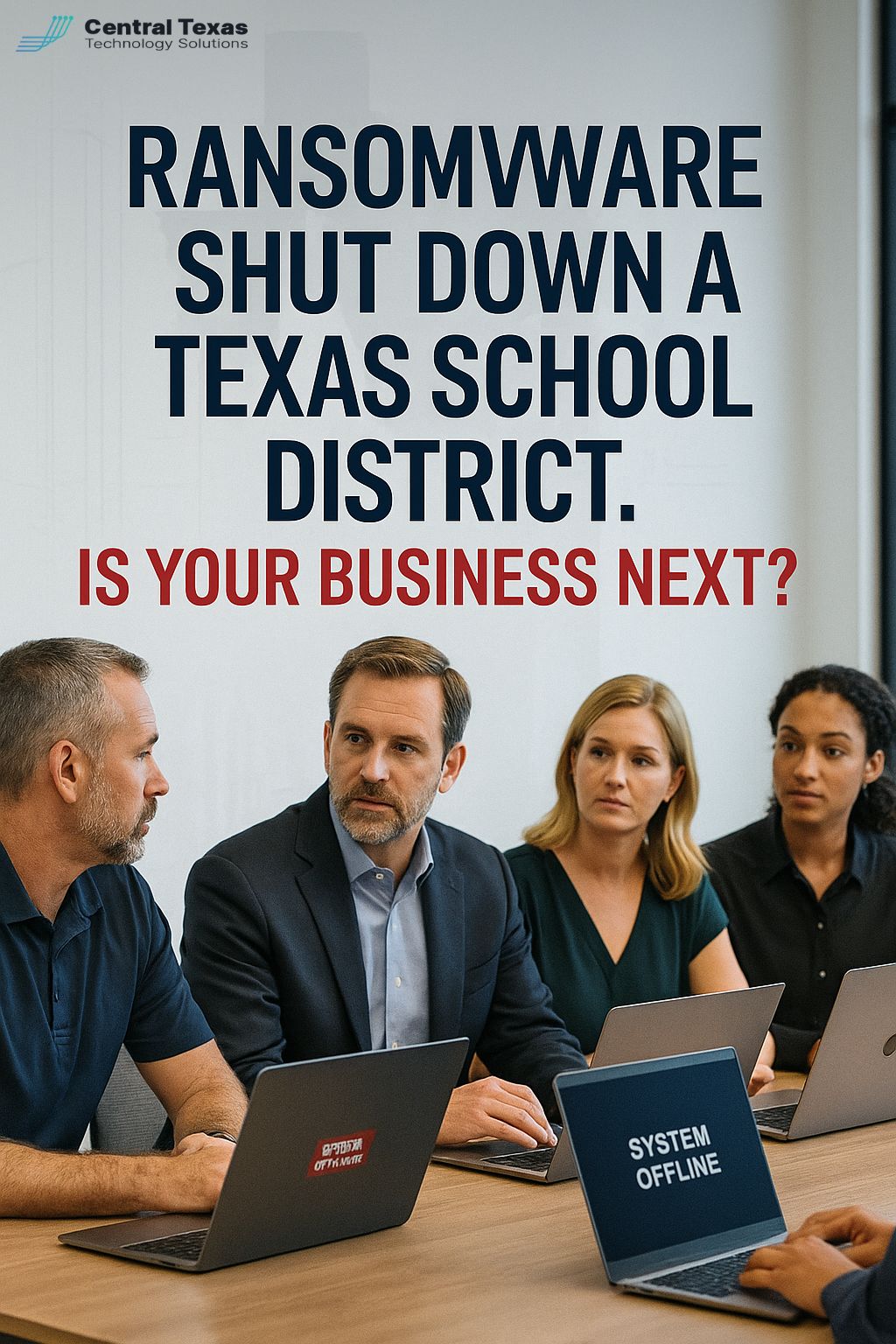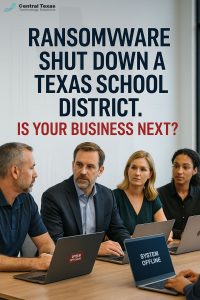
The Wake-up Call No Leader Wants
 When Uvalde CISD announced it would close Sept 15–18 after detecting ransomware across district servers, it was not simply a tech outage. Phones, camera monitoring, thermostats, and visitor management were impacted, systems that keep people safe and operations running. The district reported the incident to the FBI and began forensic analysis before recovery.
When Uvalde CISD announced it would close Sept 15–18 after detecting ransomware across district servers, it was not simply a tech outage. Phones, camera monitoring, thermostats, and visitor management were impacted, systems that keep people safe and operations running. The district reported the incident to the FBI and began forensic analysis before recovery.
Events like this are not isolated. Ransomware remains one of the most disruptive threats in the United States, with reported cybercrime losses climbing to record levels in 2024. K-12 districts have been hit hard, and the same patterns target private businesses: credential theft, remote access exploitation, third-party exposure, and weaknesses in building and IoT systems. In 2024, analyses counted over a hundred K-12 districts impacted, underscoring how quickly one attack can ripple across many sites.
For leaders across Austin, Round Rock, Georgetown, Buda, San Marcos, and surrounding communities, the lesson is clear. If a single compromise can shut down a school system, a similar compromise can stall manufacturing lines, clinic operations, law firm deadlines, or construction schedules.
The Stakes of Waiting
Downtime is measurable. Trust is not. A successful ransomware attack can halt revenue, delay client deliverables, and trigger contractual penalties. It can expose regulated data and increase insurance scrutiny. Texas ranks among the highest states for cybercrime losses, which means your clients, partners, and regulators expect stronger controls today than they did last year.
Schools illustrate a broader point for every organization: modern operations depend on connected systems that most leaders do not think about until they fail, such as HVAC controllers, IP cameras, VoIP, visitor kiosks, and badge readers. Attackers aim for where security is thin and the business impact is high. That is why ransomware remains a top concern for critical services nationally.
A Clear Path Forward With a Local Guide
CTTS is based in Central Texas and built to help CEOs, CFOs, and operators translate complex security frameworks into practical steps that actually get finished. We start by listening to how you make money, how you serve clients, and what would hurt the most if it went offline. Then we sequence the work so you see quick wins first and bigger risk reductions next.
Our approach aligns with federal best-practice guidance for reducing ransomware risk and for responding if something slips through.
Five CEO-level Moves to Cut Ransomware Risk Now
-
Backups that cannot be encrypted by attackers
Maintain offline or logically isolated, immutable backups for servers, SaaS data, and endpoints. Test restores on a schedule. The goal is to turn a potential ransom into an inconvenience, not a crisis. -
Phishing-resistant MFA everywhere
Enforce MFA on email, VPN, remote desktops, admin portals, and vendor access. Prefer phishing-resistant methods where possible and monitor for MFA fatigue. This single step can stop many initial intrusions. -
Segment networks and isolate building systems
Separate cameras, HVAC, door controllers, and production equipment from business systems. Limit who can reach what. Flat networks turn small compromises into operational shutdowns. -
Patch what attackers actually target
Prioritize updates for firewalls, remote access, external web apps, domain controllers, hypervisors, and widely exploited IoT devices. Use an inventory so you patch what you own, not what you hope you own. -
Practice the playbook with the right people
Run tabletop exercises that include leadership, legal, PR, insurance, and your MSP. Define who calls whom, how you communicate if email is down, and what “minimum viable operations” looks like for your business. The goal is muscle memory when minutes matter.
What Working with CTTS Looks Like
We keep this simple and local.
• Assess - We map your top business risks, from cloud to conference rooms to controllers
• Harden - We implement the controls that reduce the most risk per dollar
• Prove - We test restores, verify MFA coverage, and confirm segmentation works
• Monitor - We watch the environment and your vendors with clear reporting
• Coach - We train teams to recognize and report phishing quickly
You get a plan that matches your growth goals, your compliance requirements, and your budget, with clear milestones and plain-English updates.
This is What Success Looks Like
• Your team can work even if one system is offline
• A single compromised device does not become a business-wide outage
• You can tell clients and boards exactly how you protect their data
• Insurance renewals become easier because controls are verified
• Recovery is measured in hours and days, not weeks
Ready for Clarity
If you read about Uvalde’s closure and thought about how your own phones, cameras, thermostats, or visitor systems would impact operations if they went dark, you are already asking the right questions. Ransomware is not going away, but its impact can be dramatically reduced with the right foundations.
Schedule a free strategy session with CTTS
We will review your current posture, identify quick wins, and build a prioritized roadmap tailored to your organization in Austin and across Central Texas.
FAQ
Do small businesses in Austin really face the same threat as schools and hospitals?
Yes. Attackers automate initial access and go after exposed services, weak credentials, and third-party portals. The difference is impact. Smaller organizations often have fewer redundancies, so a single hit can stop everything. National data continues to show rising losses year over year.
If I have cyber insurance, why invest in more controls?
Most carriers now require MFA, backups, logging, and response plans. Strong controls lower premiums and speed claims. More importantly, they help you recover without paying a ransom.
How quickly can we make progress?
Many high-value steps happen fast once we align on priorities. MFA coverage, backup hardening, and an initial network segmentation plan are common early wins. We focus first on controls that meaningfully reduce the chance of a shutdown.
Contact CTTS today for IT support and managed services in Austin, TX. Let us handle your IT so you can focus on growing your business. Visit CTTSonline.com or call us at (512) 388-5559 to get started!
